How Online MBAs Use Technology to Enable Authentic Connections

Sponsored Content
Technology has dramatically blurred the line between the digital and offline worlds; we can do almost anything online these days, ranging from ordering groceries to exploring Africa to attending college. However, one of the points of debate across nearly all fields is how the online experience compares to the parallel offline one; this has been especially true in online degree programs: Can online degrees provide the same value as their face-to-face counterparts?
The challenge of engaging and preparing students is two-fold for online degree programs. They need to cover the same key topics and transfer the same volume of knowledge as their on-ground counterparts. However, another part of the attraction of top MBA programs is that they not only develop students’ business acumen, they facilitate long-lasting connections that can lead to career opportunities and professional connections. That level of engagement presents a much bigger obstacle than catching someone’s attention long enough to complete a simple e-commerce transaction.
Technology in the Online Classroom: Two Major Lessons Learned
One of the things that makes a great online MBA successful is technology. Of course, if it were just an issue of investing in the latest and greatest tech solutions, every university would have successful digital learning programs. Further complicating things is the boom in technology built to solve this problem; which solution is best for the online classroom, and which will help build skills that will carry over into students’ careers.

After looking at some of the technology decisions at the University of Southern California’s Online MBA program, we found two major lessons for how to be successful with the kind of engagement these programs need to facilitate.
1. Innovate With Purpose
It’s easy to see the concerns over rapid technology evolution, whether you consider this 2015 New York Times article about innovation happening too quickly for businesses to keep up, or William Smith’s Morley, in which he wrote that widely available news and faster travel options would destroy relaxation as we know it, in 1886.
The technology we use will always be changing, whether it’s 1886 or 2186. One of the things that is hard to admit, though, is that the thinkers who said it would be impossible to keep up were right. Particularly at an organizational level, it really is impossible to stay current with every technology innovation that emerges.
The difference between success and failure—in the virtual classroom and in global business—is how they adapt new technologies to their environments.
One example of this in action comes from the University of Southern California’s Online MBA program. There are countless options for encouraging deeper collaboration and facilitating connections in an online setting, including a growing list of business collaboration tools as well as universities who opt to build their own social collaboration platforms. Sometimes, though, the answer is much simpler.
One of the things that stood out from USC’s Online MBA is that, in addition to the classroom sessions and videoconferencing, students chat and connect over WhatsApp. One of the biggest lessons from this experience is the fact that, sometimes, the best solution for a given problem is something students or employees are already using; it just needs to be embraced in a way that supports desired outcomes.
Why it Matters: Both businesses and universities may be reticent to allow important work and collaboration to exist outside of the platforms they control; and, there are certain instances (i.e. regulation) where allowing consumer-grade technology is a poor choice. However, embracing a student or employee-driven approach to collaboration is essential to making it work, particularly in a virtual setting. Rather than try to force students off the tool they’re comfortably using, USC can focus on smarter investments in other areas that are critical to online learning, like high quality video conferencing and learning management systems.
2. Outcomes First, Technology Second
It may seem counterintuitive at first, but the best strategies for utilizing technology don’t start by considering technology—they start by considering desired outcomes. If the goal is to facilitate the creation of real connections in a virtual space, using technology to enable this will need to feel natural and incorporate features that bring some of the same qualities of face-to-face interaction.
For online MBAs, there is a second and critical part to solving this challenge: Increasing students’ familiarity with tools that they will need to use in their professional lives.

For both businesses and higher education institutions, approaching this problem primarily from a technology perspective is the wrong approach. By thinking about desired outcomes, organizations can better guide their technology choices.
For example, with software for videoconferencing, there are myriad options. From a purely technical standpoint, many schools might first consider a solution like Blackboard Collaborate or Canvas’ built-in conference tools because so many already have Blackboard or Canvas for their Learning Management Systems.
These platforms may be enough from a functional standpoint, but, for developing true connections in an online MBA, user experience is an even more critical element of software used for video and teleconferencing. Considerations like these led USC’s Online MBA program to leverage Zoom, a dedicated communications platform, for conferencing in addition to the Canvas LMS for facilitating learning. Zoom lets students see the instructor, as well as their fellow classmates on live video, making it closer to face-to-face interaction than many alternatives. It’s also easier to schedule meetings on short notice with the ability to send calendar invites, offering similarity to the spontaneous brainstorming sessions that might happen in a classroom or office.
Why it Matters: The best solution for a given problem isn’t always the one that comes integrated with the rest of the software organizations already have. Especially for an online MBA, it’s also important to consider technology that has value beyond the classroom, as this will better equip students to succeed in their careers. The second component of this is to think about software that readily integrates with platforms people use in their daily lives anyway. Even if it is just the ability to send a meeting invite over Google Calendar, individual features can make the difference.
The Results: When Technology is Used Effectively
The biggest result of USC’s smart use of technology is that students can and do form real connections that lead to face-to-face interaction. For example, many students organize meet-ups in their area, so that those who live away from campus can still participate in the Online MBA community.
The deeper social connections, coupled with classroom learning and group discussions, also create unique opportunities that would not be as easily made without digital engagement. In USC’s case, one team of students in the recent cohort is planning to open their own business together.
The Bottom Line: Universities have historically struggled to keep pace with technology adoption. Regardless of whether a program is online, offered on-campus or uses a hybrid approach, though, the best MBA programs will stay ahead of the curve by considering outcomes first and avoiding the temptation to innovate without a clear purpose.
To learn more about the USC Marshall School of Business Online MBA, visit the Marshall website.
The California MBA Program Guide

If you’re looking to earn a California MBA, where should you go to school? Should you choose a top MBA program in Los Angeles or San Francisco? Both cities offer beautiful weather, gorgeous beaches, and world-class business education, but is one location better than the other?
Los Angeles vs. San Francisco
To get started, it’s necessary to compare the cost of living in Los Angeles and San Francisco. According to Numbeo, the world’s largest database containing user contributed data about cities, San Francisco is far and away the more expensive place to live. You would need $7,748.24 in San Francisco, CA to afford the same lifestyle that you can have for $5,700 in Los Angeles. That’s just over $2,000 more per month needed to live in San Francisco, and here’s how that’s broken down.
- Consumer Prices:98 percent higher in San Francisco
- Rent Prices: 51 percent higher in San Francisco
- Restaurant Prices: 62 percent higher in San Francisco
- Groceries Cost: 8 percent higher in San Francisco
- Local Purchasing Power: 77 percent higher in San Francisco
Right off the bat, it’s obvious that the cost of rent (real estate) is what will eat up most of your paycheck in San Francisco, but is that offset by anything? Here are the other things to consider when choosing between San Francisco and Los Angeles.
- Industries
- Los Angeles is ranked top in the country for manufacturing with over 500,000 workers in the industry. Other top industries include banking and finance (more than 100 foreign and domestic banks), entertainment, and tourism.
- San Francisco, on the other hand, is known as Silicon Valley (with San Jose) for its technology companies and startups (Intel, Apple, Genentech, Google, Uber, and Twitter). It’s also a great city for finance, global business, medical science, biotechnology, tourism, and fashion apparel (home of the Levi Strauss & Co headquarters).
- Economic Development: According to the Center for Jobs, San Francisco far and away outperforms Los Angeles in terms of economic growth and development with the Bay Area growing year-over-year while LA has struggled with almost consistent decreases.

- Top Companies: California is home to 53 Fortune 500 companies, second only to NYC. And more of those companies are located in the Bay Area compared to Los Angeles. San Francisco is home to Apple (3), McKesson (5), Chevron (19), and Wells Fargo (25). While Los Angeles is home to Aecom (161), CBRE (214), and Reliance Steel & Aluminum Co (320).
Los Angeles vs San Francisco MBA Programs
The next step is to compare the top three MBA programs in each city. In particular, we wanted to take a look at the tuition rates (two years), GMAT averages, and post-graduation salaries at each program in each city to get a well-rounded picture.
There are a few things to note right away.
- San Francisco is home to more highly ranked MBA programs with two ranking in the top ten on every list. However, it’s important to note that both cities have programs that rank well and are considered top tier schools.
- The average tuition in each city is fairly even. However, the most expensive ($137,00) and the most affordable ($77,000) schools are located in San Francisco, whereas Los Angeles is more even regarding tuition across the board.
- You’ll need a better GMAT score to go to a school in San Francisco, and that GMAT score translates into a higher salary after graduation. San Francisco graduates earn about $11,000 more per year compared to their LA counterparts.
Here’s how it all breaks down per school.
Top 3 Los Angeles MBA Programs
Anderson School of Management – UCLA
The UCLA Anderson School of Management offers a full-time MBA, a part-time MBA, an Executive MBA, and a UCLA-NUS Global MBA (Asia Pacific) program. It’s considered one of the top business schools in the world, ranking 6th in the Economist, 15th in Forbes, 16th in the U.S. News & World Report, and 25th in Financial Times.
- Tuition Rates (two years): $117,176
- GMAT Averages: 719
- Post-Grad Salaries (Mean): $119,964
Marshall School of Business – USC
The Marshall School of Business at USC offers a full-time MBA program, a part-time MBA, an Executive MBA, and IBEAR (International Business Education and Research) MBA, and an Online MBA program. The school’s full-time MBA program is ranked: 20th in the U.S. News & World Report, 33rd in Forbes, 59th in Financial Times, and 65th in the Economist.
- Tuition Rates (two years): $116,361
- GMAT Averages: 703
- Post-Grad Salaries (Mean): $115,309
The Paul Merage School of Business – University of California, Irvine
The Paul Merage School of Business has both a full-time MBA program as well as a part-time fully-employed MBA program. In addition, the school offers an Executive MBA and a Health Care Executive MBA program. The business school is ranked highly across multiple rankings including 41st in Forbes, 42nd in the U.S. News & World Report, 56th in the Economist, 64th in Financial Times.
- Tuition Rates (two years): $87,661
- GMAT Averages: 652
- Post-Grad Salaries (Mean): $97,808
Top 3 San Francisco MBA Programs
Haas School of Business – UC Berkeley
The Haas School of Business offers a full-time MBA, part-time MBA, and Executive MBA program. Haas is ranked as one of the top business school’s in the world ranking in the top ten on every list: 7th overall in U.S. News & World Report and 7th overall in the Economist, as well as 9th overall in Forbes, and 10th overall in the Financial Times.
- Tuition Rates (two years): $117,444
- GMAT Averages: 725
- Post-Grad Salaries (Mean): $125,573
Stanford University Graduate School of Business
The Stanford University Graduate School of Business offers only a full-time MBA program, but it’s one of, if not the top two-year program in the world. When looking at how Stanford GSB stacks up to the competition, the rankings speak for themselves with all in the top ten and most in the top five, including: 1st overall in the Financial Times, 2nd overall in Forbes, 4th in the U.S. News & World Report, and 9th in the Economist.
- Tuition Rates (two years): $137,736
- GMAT Averages: 733
- Post-Grad Salaries (Mean): $144,455
UC Davis Graduate School of Management
At the UC Davis Graduate School of Management, MBA applicants can apply to the full-time MBA or the part-time MBA program. Once again, UC Davis is one of the top schools in the world, ranking 37th in the U.S. News & World Report, 63rd in Forbes, and 67th in the Economist.
- Tuition Rates (two years): $77,698
- GMAT Averages: 669
- Post-Grad Salaries (Mean): $97,695
California MBA Breakdown in Charts
When breaking down the data between MBA programs in Los Angeles and San Francisco, here’s what it looks like
California MBA Tuition (Los Angeles vs. San Francisco)
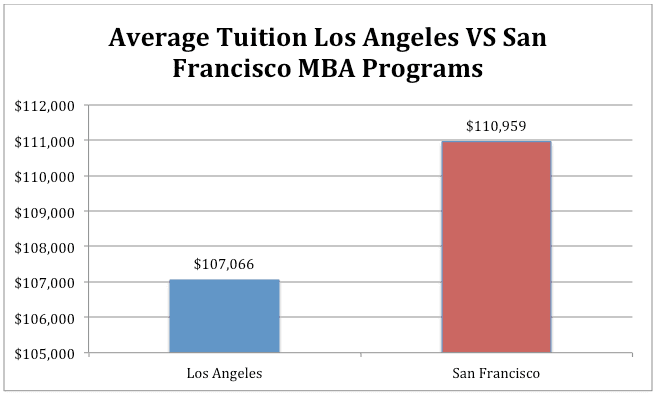
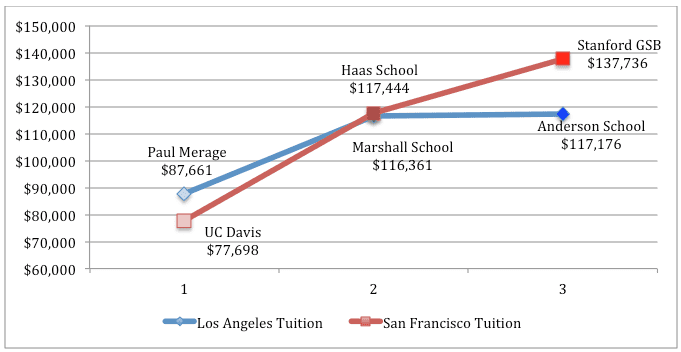
California MBA GMAT Averages
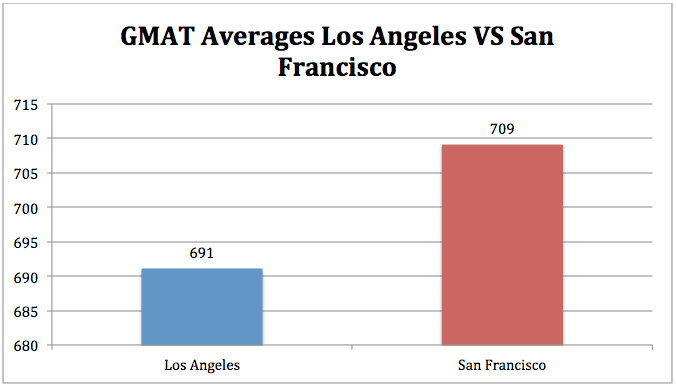
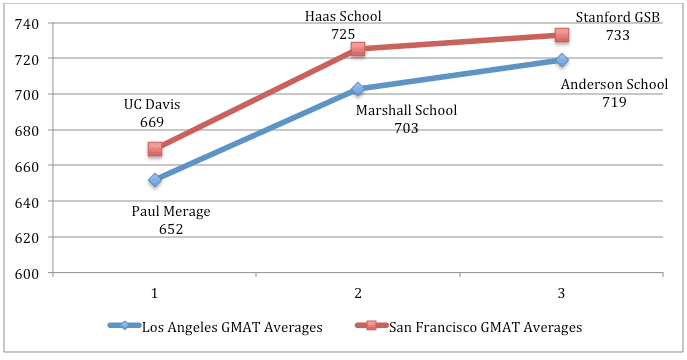
California MBA Post-Graduation Salaries
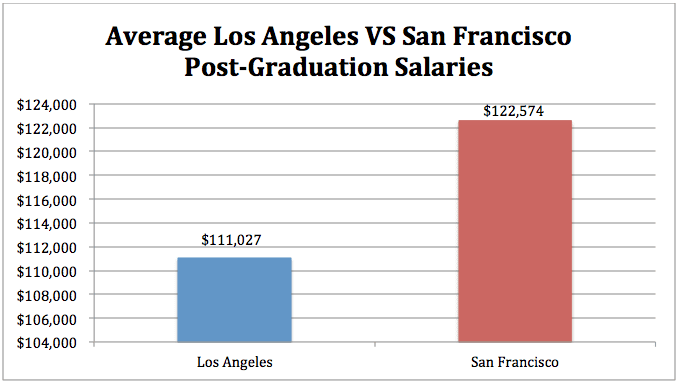
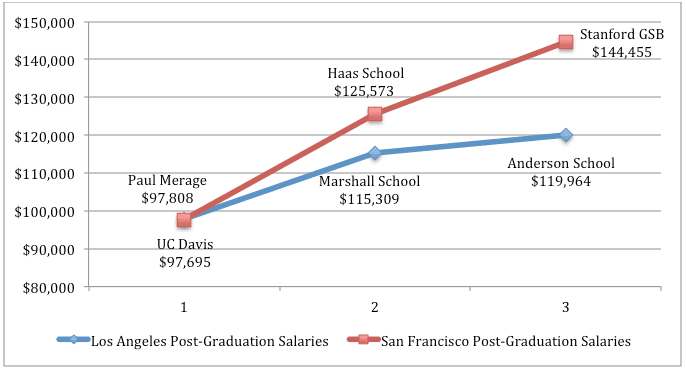
USC Tells the Story of Their Own Hero, and More – Los Angeles News
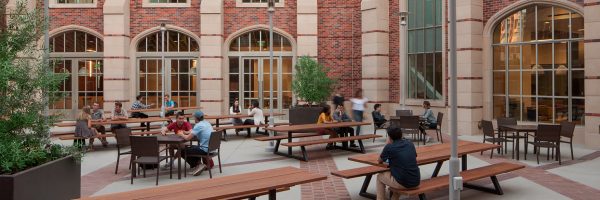
We’ve rounded up the top news stories coming out of the Los Angeles metro this week.
A Hero MBA – USC Marshall Newsroom
The Marshall School of Business at USC recently celebrated the graduation of the MBA Class of 2018, including Marine Corps Cap. Corban Pierce. Pierce, his MBA now in hand, hopes to use his degree to start a nonprofit that will help children around the world.
“I wanted to find a school that shared my values of entrepreneurship and helping people,” Pierce recalled on his decision to attend Marshall in a recent interview. “I found that spirit at USC.”
Pierce, who has served the country as the executive officer at Reconnaissance Training Company in the Marine Corps. He was attracted to USC for their combination of unrelenting high standards and flexibility. Pursuing the online MBA at Marshall, Pierce was able to continue his work training young Marines at Camp Pendleton, be a father to his five-year-old son, and still earn his degree. He plans to continue his military service after graduation, and is excited to put the skills he learned in the program to work. “It’s not about solving major crises,” Pierce said, commenting on his long-term goal of using business to create lasting change.
“It’s solving small things.”
You can read more about Pierce’s experience with the USC Marshall Online MBA here.
California Gains More Than 39,000 jobs; Unemployment Falls to Record Low – LA Times
A recent LA Times report from the Employment Development Department revealed a boost in the California economy throughout April, despite worries of an economic downturn. In March, the unemployment rate in the state had fallen to a record low of 4.2 percent, but April showed widespread job growth throughout multiple sectors. In the professional and business services sector alone, California witnessed an increase of 8,500 jobs.
“Each month in 2018, it seems that California’s employment boom will end, and each month it continues,” commented former director of the Employment Development Department Michael Bernick. In fact, all metros in Southern California saw an increase in the number of jobs throughout April. With 11,200 added jobs, San Diego County had the highest of any region in the state, and Los Angeles was close behind with an increase of 6,400.
“Good numbers,” said Dave Smith, an economist at the Pepperdine University Graziadio School of Business and Management. “There are no signs of a potential downturn. The potential risk factors are overheating.”
Read more about California job gains and the employment report here.
ABC’s Move to Ax ‘Roseanne’ Reflects Businesses are Often at Front Lines of Culture Wars – U.S.A. Today
UCLA Anderson School of Management Jay Tucker, executive director at the Center for Media, Entertainment & Sports, recently commented on the cancellation of the Roseanne reboot by the ABC network, after its titular star, Roseanne Barr, posted several inflammatory tweets regarding Valerie Jarrett—a former aide under President Barack Obama—in comparison to apes from the ‘Planet of the Apes’ film franchise.
In an interview with USA Today, Tucker remarks, “In an earlier (TV) era, it would have taken half a season to make that decision after much internal analysis.”
“But the network now faces a backlash from other quarters. Many of the comedian’s fans blame the show’s cancellation on political correctness and are threatening a boycott of their own.”
You can read the remainder of the article here.
Los Angeles News: Chapman Alum Returns as New COO, and More
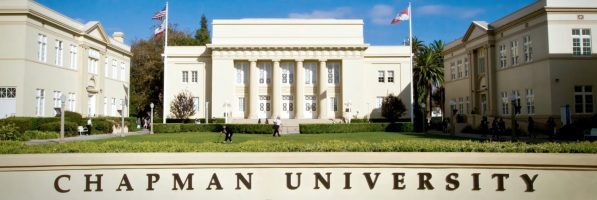
Let’s take a look at some of the biggest news coming out of Los Angeles business schools this week.
Brian’s Journey to COO: An MBA Network That Made Career Aspirations Reality – Chapman University Newsroom
The Argyros School of Business at Chapman University profiled alumni Brian Goodman, whose experience in the Chapman MBA program led him to a role as Chief Operating Officer.
Goodman, who had been working as a corporate attorney, entered Chapman’s EMBA program in the fall of 2015, quickly taking advantage of the many networking opportunities the program offered. It was through one of these MBA-association events that Goodman met Robin Follman-Otta, who would ultimately help shape his career by offering him the COO role at her firm, Markall Incorporated and RA Industries. Although Goodman never expected finding himself in the manufacturing industry, he joined Robin’s company shortly after his May 2017 graduation and has found it a perfect fit. He credits the Chapman EMBA program with providing him both the professional network and experience to make crucial progress in the business world.
Read more about Goodman’s experience at the Chapman EMBA program here.
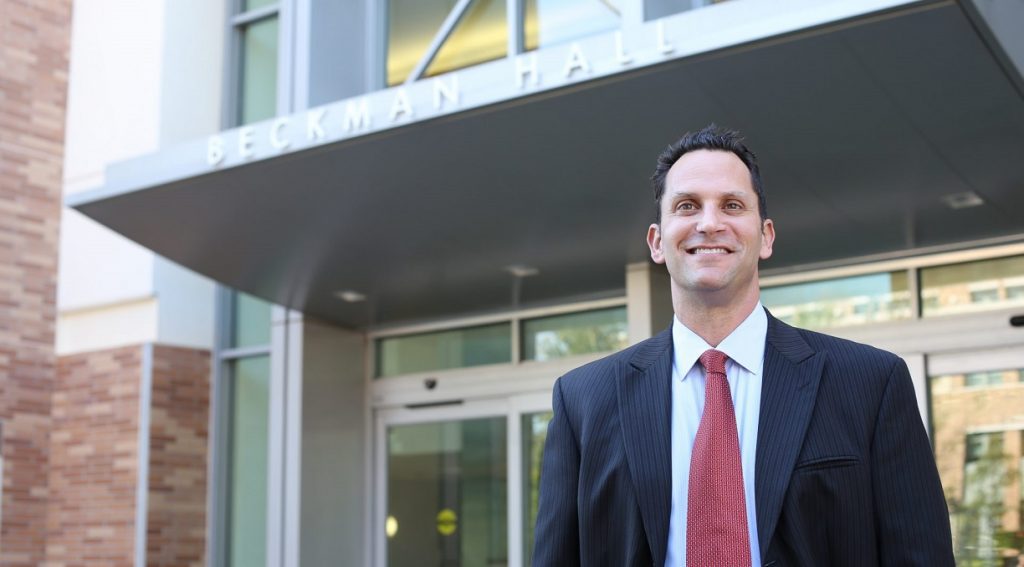
Brian Goodman, the new COO of the Chapman MBA program / Photo via blogs.chapman.edu
Center for Women in Leadership Hosts Outreach Conference – Pepperdine Newsroom
The Graziado School of Business and Management at Pepperdine University recently hosted the Women in Leadership Reachout Conference on February 13 in Malibu. The day-long event involved discussion panels revolving around issues that impact women in business, such as moving through male-dominated fields, work/life balance, and strategies and goals for mentorship.
“The conference brought C-suite level women to our campus to share real-life stories of making it to the top and thriving once you get there,” said director of the Center for Women in Leadership and Graziado professor Bernice Ledbetter. “Audience members were given a once-in-a-lifetime opportunity to learn from some of the top women executives in the nation.”
The event was presented as a partnership with C200, which also presented $10,000 scholarships to three exemplary female MBA students.
You can read more about the Women in Leadership conference at Graziado here.
How and Why Cal State Fullerton Students Launch Companies Before They Graduate – The Orange County Register
The Orange County Register recently took a deeper look into the New Venture Creation and Funding class at the Mihaylo College of Business. The program, which has about 200 majors, encourages students to create startups even before graduation day—with the full support of mentors and faculty at Mihaylo. The program centers around the idea of the “lean startup,” which looks for market input early on in development. After students have created their pitch, a panel of investors hear their ideas and often are so inspired they offer funding on the spot.
Successful companies from past entrepreneurship students have included a local craft beer maker Bootlegger’s Brewery; a tutor service which helps connects students with tutors who have been through the same class, Wecademi; and an online piano lesson service called Piano with Johnny.
Read more about the Mihaylo entrepreneurship program here.
These LA Business Schools Are Helping Low Income Students Pursue Their Dreams – MetroMBA
Last week, we profiled several schools in the Los Angeles metro area, including the UCLA Anderson School of Management and Marshall School of Business at USC, which provide ample opportunities for in and out-of-state prospective MBA students that need financial assistance with their education. As well, we highlighted many of the offerings available to military veterans.
For low-income MBA applicants who also have a history of military service, there are many unique financial aid opportunities. The exact services available will depend on the school, but some of these programs are available at schools across California and the U.S.
First, there’s the Yellow Ribbon Program, which many Los Angeles business schools take part in, including Chapman University Argyros School of Business. This program awards MBA students up to $6,000 for tuition and fees. Another program open to military veterans is the Post-9/11 GI Bill, which includes payments directly to the university for tuition and fees, a monthly housing allowance, and an annual books and supplies stipend up to $1,000 per year.
Individual schools like the USC Marshall School of Business also offer their own specific scholarships for military veterans. The Schoen Family Scholarship Program for Veterans is available to full-time MBA students at Marshall and has, to date, provided a staggering $1.2 million in financial support to 173 students at the university.
You can read more about the financial opportunities for lower-income applicants here.
USC Marshall Makes Top 50 in Net Impact’s Guide to Grad Schools
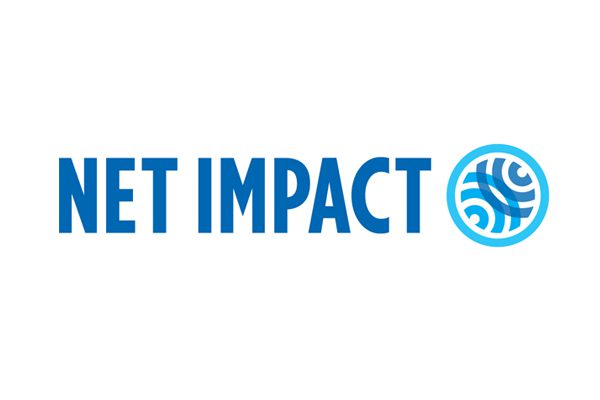
Net Impact’s 2014 “Business as UNusual” guide ranked the Marshall MBA in the top 50 schools for Social Impact Programs (tied for 28th) and Environmental Sustainability Programs (tied for 31st). Continue reading…
Marshall Selected as Critical Partner at Expo Milano

USC Marshall School of Business has been selected as a critical partner in shaping the U.S. presence at Expo Milano 2015, the latest incarnation of the historic world’s fair.
On target to open its doors next May, Expo Milano, built around the theme “Feeding the Planet, Energy for Life,” will offer countries around the world an opportunity to showcase their strengths and capture their national spirit as they tackle one of the most pressing issues of our time: hunger and food insecurity.
For the second consecutive Expo, Friends of the USA Pavilion Milano 2015 has tapped USC Marshall to lead recruitment and training of its student ambassadors, a pivotal role in ensuring the pavilion’s success.
